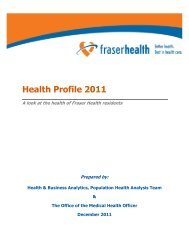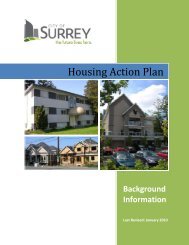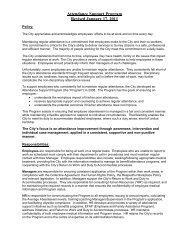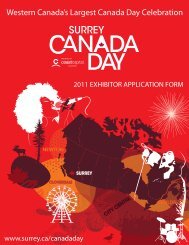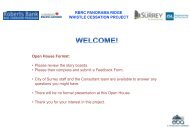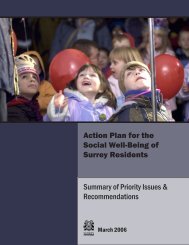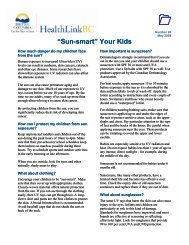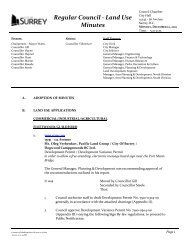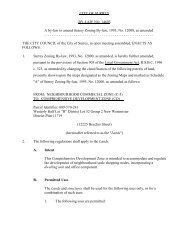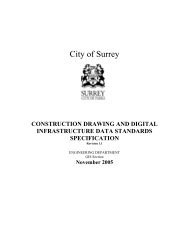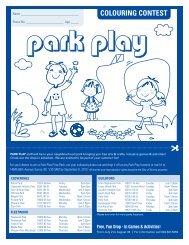Blackie Spit Park: Wildlife Habitat Enhancement Plan - City of Surrey
Blackie Spit Park: Wildlife Habitat Enhancement Plan - City of Surrey
Blackie Spit Park: Wildlife Habitat Enhancement Plan - City of Surrey
You also want an ePaper? Increase the reach of your titles
YUMPU automatically turns print PDFs into web optimized ePapers that Google loves.
Management Unit 18: <strong>Park</strong>ing Lot<br />
1.0 Existing Conditions<br />
Management Unit 18 is a gravel parking lot (Drawing 13) (Figure 47). Part <strong>of</strong> the MU, the south end<br />
<strong>of</strong> the area southwest <strong>of</strong> the swimming club/tennis club, is mostly grass/forb, with two small groves<br />
<strong>of</strong> large cotton trees. Washrooms are also located there.<br />
2.0 Goals and Objectives<br />
Species Management Goal<br />
None, this area is a parking lot.<br />
<strong>Habitat</strong> Management Objectives<br />
• Create more efficient parking.<br />
• Extend parking lot, if necessary after above, to replace number <strong>of</strong> parking spaces<br />
decommissioned in MUs 15 and 16.<br />
3.0 Management Prescriptions<br />
The Master <strong>Plan</strong> calls for expansion <strong>of</strong> the portion <strong>of</strong> the parking lot south <strong>of</strong> the tennis court, into<br />
an area adjacent to MUs 9 and 10. However, this wildlife habitat management plan proposes instead<br />
to expand the portion <strong>of</strong> the parking lot that is north <strong>of</strong> the sailing club into an area that would<br />
otherwise be part <strong>of</strong> MU 13. The reason for the difference is that much <strong>of</strong> MU 13 appears to have<br />
been once used for parking or some similar purpose. The substrate <strong>of</strong> MU 13 (on both sides <strong>of</strong> the<br />
ditch) is a mixture <strong>of</strong> small gravel and sand, is very compacted, and the vegetation volunteering there<br />
is largely non native species (tansy, blackberry, reed canarygrass, laburnum and other introduced<br />
trees). On the other hand, the substrate <strong>of</strong> MU 9 and adjacent non parking parts <strong>of</strong> MU 18, like all<br />
upland areas northwest <strong>of</strong> the MU 7 dyke, is sand more than a metre deep, and the vegetation<br />
volunteering there, with the exception <strong>of</strong> some blackberry along the parking lot edge, comprises a<br />
number <strong>of</strong> desirable grass, forb and, woody species.<br />
There appears to be no compelling ecological reason to make the part <strong>of</strong> MU 13 adjacent to MU 18<br />
a habitat area at the expense <strong>of</strong> the grass/forb habitat along the northeast side <strong>of</strong> MU 9 or <strong>of</strong> the treed<br />
parts <strong>of</strong> southeast MU 18 and adjacent portions <strong>of</strong> MU 10. Management inputs would likely be<br />
much higher and success rates lower in MU 13 where elimination <strong>of</strong> undesirable species is a major<br />
factor, compared with MU 9 and southeast MU 18 where it is not.<br />
3.1 Initial <strong>Enhancement</strong> Requirements<br />
• Expand the parking east <strong>of</strong> the sailing club lot southeastward as much as necessary to allow a<br />
maximum amount <strong>of</strong> parking in the central area <strong>of</strong> the lot. This may entail as little as moving<br />
the boulders that delineate the parking lot boundary, and cutting or otherwise removing and<br />
controlling the largely herbaceous vegetation.<br />
<strong>Blackie</strong> <strong>Spit</strong> <strong>Park</strong>: <strong>Wildlife</strong> <strong>Habitat</strong> <strong>Enhancement</strong> <strong>Plan</strong> – Management Unit 18 76



